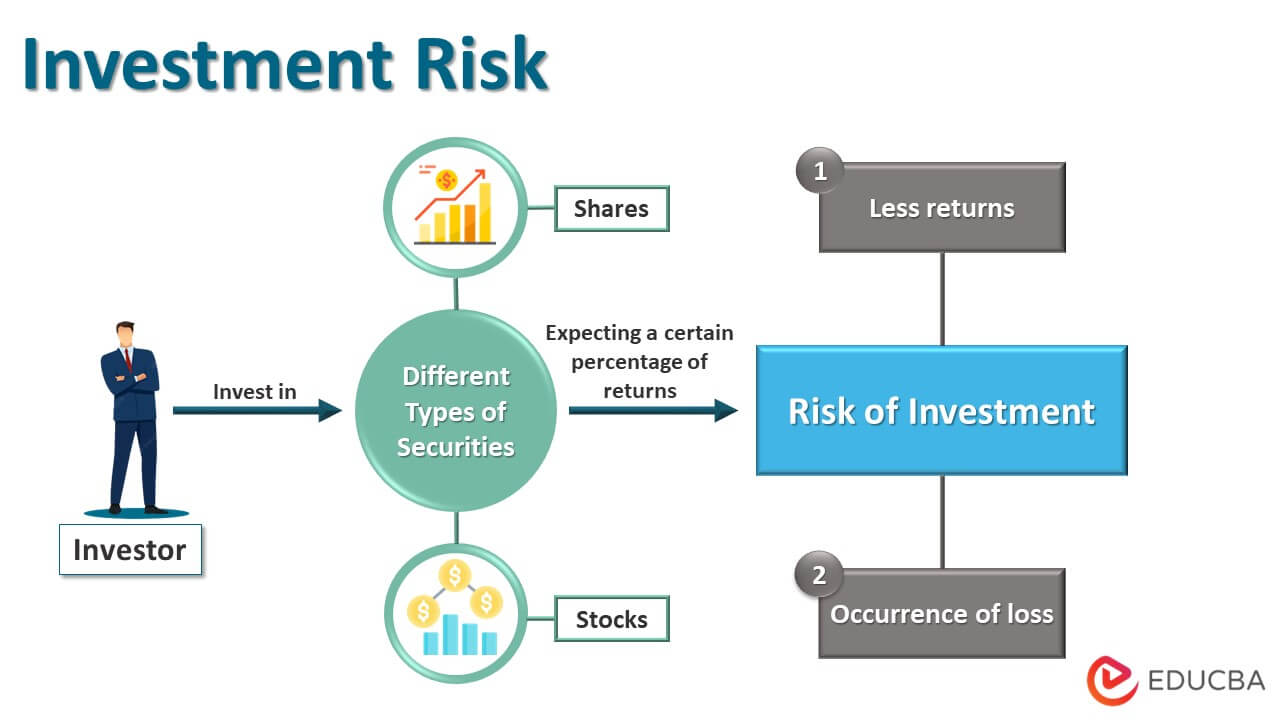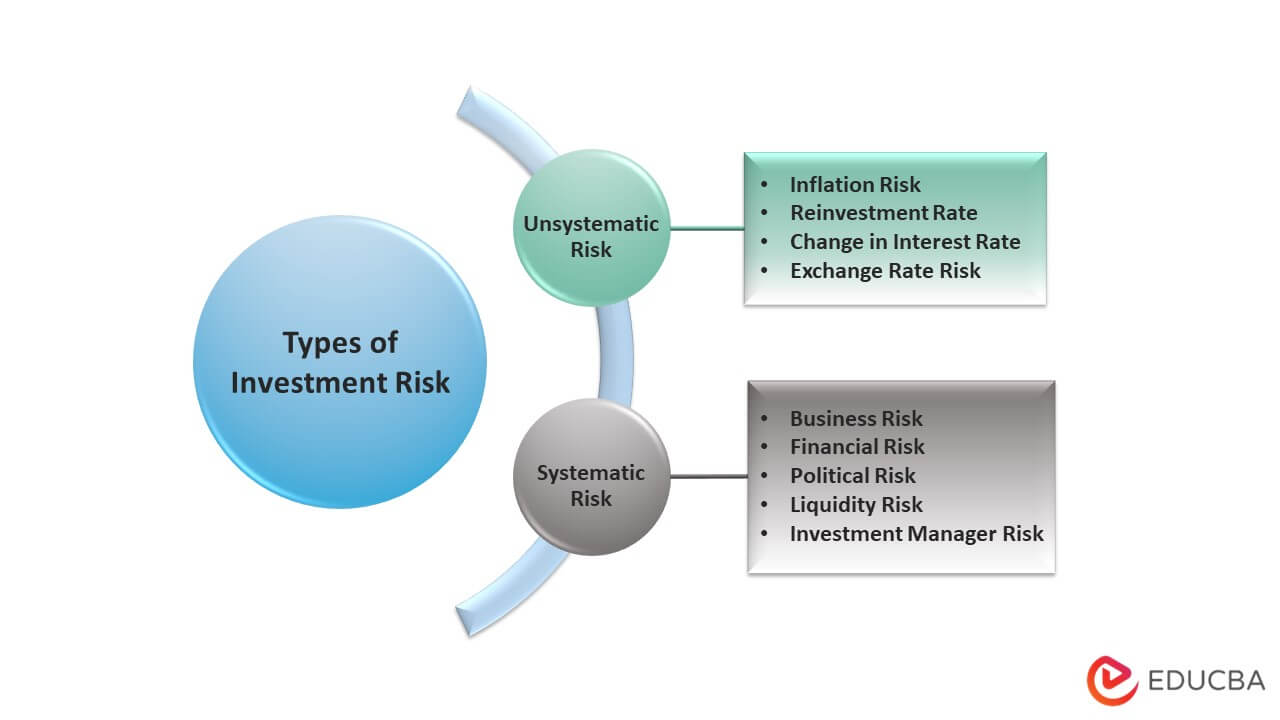Updated July 17, 2023
Definition of Investment Risk
When investors invest their money in different types of securities or investment options, they expect a certain percentage of return on their investments. But as it happens, there is always the possibility of gain and risk of loss on the fund invested.
The risk of occurrence of loss on the investment or return less than the expectation is termed investment risk. Sometimes investors lose their real money if investment risk is not managed effectively.
Explanation
The investment risk is associated with each type of investment, though the risk varies accordingly. For example, investment in fixed interest bonds or debentures carries very little, while the risk associated with investing in securities, shares, stocks, and options is relatively higher. Investors invest according to their risk appetite or unique risk profile. Higher the risk appetite to take investment risks higher the expected rate of return by the investors.
Investors generally need to have an understanding of essential investment risks before investing. They also need to know how different risks can be applied to other investment scenarios. This will help them manage the investment risk holistically and help avoid significant and unnecessary losses.
Example of Investment Risk
Let us take an example where a person invests in an investment option and expects a yearly interest of a certain percentage every year. He intends to purchase an asset with the investment money after ten years and contributes yearly to the investment fund.
After performing all the calculations, he expects to receive $100,000 after ten years and can pay for the asset after ten years comfortably. The expected value of the asset after ten years is $90,000. Now the inflation rate is 4%. So after applying the inflation rate to the expected value, the actual value would be $133,222, while the return from the investment would be $100,000. This is an example of inflation risk.
Types of Investment Risk
Investment risk is further divided into two broader categories, systematic risk, and unsystematic risk. Systemic risk is market-related and cannot be reduced or avoided through portfolio diversification. Unsystematic risk is a non-market-related risk and can be reduced to an extent by reducing the existing portfolio. Let us now look into further subcategories of investment risks under systematic and unsystematic risk.
1. Systematic Risk
- Inflation Risk: The risk of reduction in the actual worth of the investment and its return due to inflation. This type of risk majorly impacts fixed income interest securities as inflation or purchasing power risk can erode the actual worth of the investments.
- Reinvestment Rate: The risk of reinvestment of investment proceeds at a lower rate than the original investment, which generated the profits. Long-term investments, stock, and zero-coupon bonds are the most impacted type of investments under this risk category.
- Change in Interest Rate: Any change in interest rates due to market forces or regulatory laws will impact the return of the investments.
- Exchange Rate Risk: The risk associated with fluctuation in the value of the current of the investment, due to which the actual worth of the asset is reduced. This primarily impacts the investment of foreign companies.
2. Unsystematic Risk
- Business Risk: The impact on the investment return due to the fluctuation in the business’s or company’s operating income is termed a business risk.
- Financial Risk: The risk of a lower rate of return due to a change in the economic structure of the company is termed a financial risk; for example, a company that is unable to meet its liabilities won’t be able to pay dividends or interest.
- Political Risk: Political risk includes changes in legislation, laws, trade barriers, etc., that could negatively impact the expected rate of return on the investment.
- Liquidity Risk: The risk associated with not being able to convert the investment into ready cash at the time of need or not finding a buyer in the market is termed liquidity or marketability risk.
- Investment Manager Risk: The risk associated with the inability of the investment manager to manage the risk effectively is termed investment manager risk.
Investment Risk Management
Investment risk management comprises of below steps:
- In the first step, all the risks relating to the investment portfolio must be identified and noted. The investment managers should cover different risks to which the investment is exposed, including systematic and unsystematic risks.
- In the next step, the investment managers should look into the analysis of the risk part; they should define the scope of the investment risk and consider all the factors that can impact the size of the risk.
- In this step, different types of investment risk associated with the portfolio should be ranked accordingly. The risk that would highly impact the return should be rated the highest. This will help management to focus on a higher rating risk that could result in significant losses.
- In this step, managing the risk already defined in previous steps is taken care of by deploying various management strategies and would-be solutions. In other words, in this step, the investment managers work towards eliminating or at least containing the risk.
- Some investment risks cannot be eliminated or uprooted; these risks need to be monitored and reviewed from time to time to check the intensity of their impact on the return.
Disadvantages
The disadvantages of investment risk are as follows:
- Managing investment risk comprises complex calculations and is a very time-consuming process.
- The company will have to bear losses if the investment manager cannot manage risk effectively.
- Some investment risks depend on external factors that are not easy to manage.
- It involved massive investment from the company’s side, thus increasing cost.
- The accurate determination of investment risk depends upon various factors, including the model’s strength, the validity of assumptions, and the data quality.
Conclusion
From the above discussion, it is clear that investment risks cannot be wholly separated from the investment but can be managed, contained, and reduced. Different investment risk types fall under the broad category of systematic and unsystematic risk. The investment managers managing the risk need to be highly skilled and have a solid understanding to manage the investment risk better.
Recommended Articles
This is a guide to Investment Risk. Here we also discuss the introduction and Types of Investment Risk along with examples and disadvantages. You may also have a look at the following articles to learn more –





